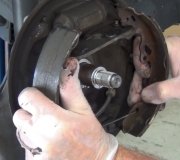Also, based on the comment "it's not driven very often", don't overlook a constricted front rubber hose. Rust builds up inside the bracket that holds the center of the hose. The growing buildup squeezes the hose. You can peel the crimp open slightly with a channel lock pliers to solve the problem. There's plenty of fluid pressure from the brake pedal to easily get past the restriction to apply the brake, but very little pressure to push the fluid back so it keeps the piston applied. As that brake caliper and the fluid inside it gets warm, the fluid expands which increases the pressure and heat buildup.
If this is the cause of one sticking caliper, the vehicle will not move on its own when sitting in neutral on a slight incline. It might move freely after a minute or two after the trapped brake fluid seeps out of the constricted hose. Another test is to jack the front end up, pump the brake pedal a couple of times, then look for the wheel that won't spin freely. Open the bleeder screw on that caliper. If you see a little spurt of fluid and the wheel spins easily, the hose is constricted. If the wheel still doesn't release, suspect rust or dirt buildup on the caliper piston causing it to not retract properly. Rebuilt calipers are so inexpensive today, it doesn't pay to rebuild one yourself.
One word of warning. If you replace a caliper or hose and want to bleed the air out of the system, just open the bleeder screw, loosen one cap on the reservoir, and let it gravity bleed for a minute or two until fluid drips from the screw. Finger-tighten the screw, stroke the pedal a few times by hand to irritate any air bubbles and push them into the caliper, then open the bleeder screw one more time and watch the few little remaining bubbles come out. Some people insist on pedal-bleeding with a helper. That works too if you need to do all four wheels in a hurry, but absolutely NEVER, never, ever push the pedal all the way to the floor. With high mileage vehicles, you will do permanent damage to the master cylinder. The two pistons with their lip seals only run in the upper half of their bores. Crud and corrosion build up in the lower halves. When you push the pedal to the floor, you run the lip seals over that crud and rip them. This results in a pedal that slowly sinks to the floor when you hold steady pressure on it. In many cases, the rebuild kit costs more than a rebuilt master cylinder.
If you have to replace the master cylinder, there is an easy trick that prevents the need to bleed at any of the wheels. It can all be done in a minute or two right at the lines coming out of the master cylinder.
Caradiodoc
Monday, December 18th, 2017 AT 9:03 PM
(Merged)











